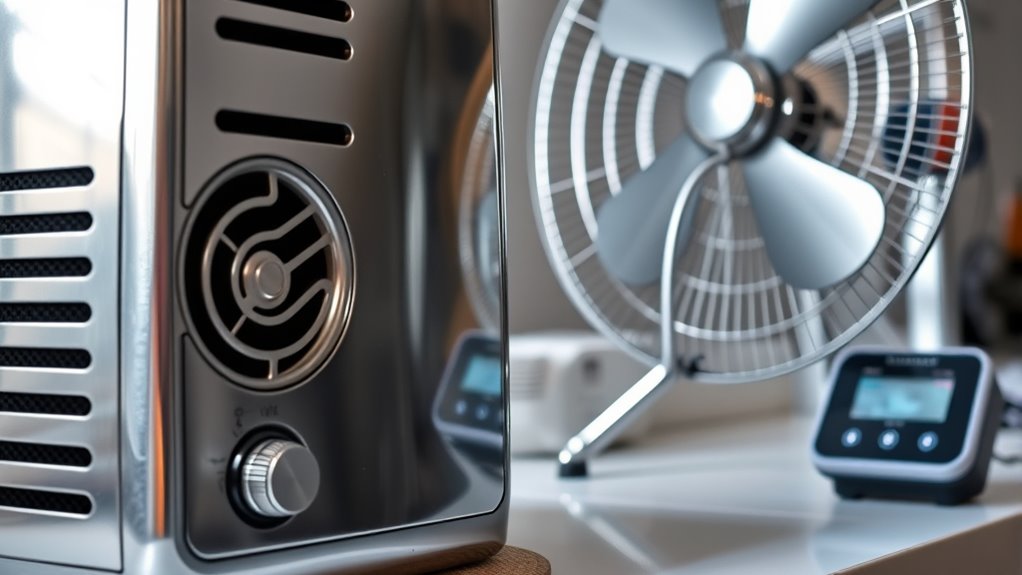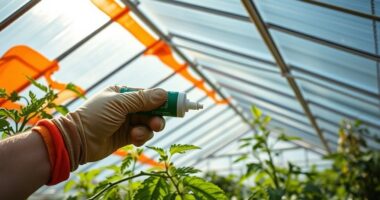To care for your heaters, fans, and sensors, regularly inspect and clean them to guarantee peak performance. Check insulation on heaters and motor housings, replacing damaged material promptly. Calibrate sensors and thermostats often to maintain accuracy and prevent overheating. Keep fan blades and vents free of dust to ensure proper airflow. Maintaining these components improves efficiency, reduces breakdowns, and prolongs their lifespan. Keep these tips in mind to keep your equipment in top shape—there’s more to learn here.
Key Takeaways
- Regularly inspect insulation on heaters, fans, and sensors to prevent energy loss and ensure proper heat retention.
- Clean fan blades, vents, and sensor surfaces periodically to maintain optimal airflow and accurate readings.
- Calibrate sensors and thermostats regularly to ensure precise temperature control and system efficiency.
- Check and replace damaged or degraded insulation promptly to avoid overheating and energy wastage.
- Perform routine maintenance on heaters and fans, including verifying calibration and inspecting electrical components, to extend equipment lifespan.

Proper equipment care is vital to guarantee your tools and machinery perform reliably and last longer. When it comes to maintaining heaters, fans, and sensors, paying attention to details like thermal insulation and equipment calibration can make all the difference. Ensuring your equipment is well-insulated helps prevent unnecessary energy loss and maintains consistent performance, especially in temperature-sensitive applications. Good thermal insulation not only improves efficiency but also reduces wear and tear caused by overheating or extreme temperature fluctuations. Regularly inspecting and upgrading insulation materials keeps your equipment operating at peak levels, saving you money on energy bills and reducing downtime. Security considerations related to equipment operation also emphasize the importance of consistent maintenance to prevent vulnerabilities. Equipment calibration plays a pivotal role in maintaining accurate readings and reliable operation. Over time, sensors and thermostats can drift from their original settings, leading to inefficiencies or faulty outputs. You should routinely check and calibrate these devices to guarantee they’re providing precise data. Proper calibration guarantees that your heating systems respond accurately to temperature changes, preventing overheating or underperformance. When sensors are correctly calibrated, your fans and heaters work in harmony, maintaining a stable environment and avoiding unnecessary strain on the equipment. This not only prolongs the lifespan of your machinery but also enhances safety and process consistency. Maintaining heaters involves more than just ensuring they’re clean; it’s also about managing their thermal insulation and verifying that control systems are functioning properly. Regularly inspecting insulation around heating elements prevents heat loss and keeps the equipment running efficiently. If insulation becomes damaged or degraded, replace it promptly. Additionally, checking the calibration of temperature controls ensures your heaters operate within the desired range. Faulty calibration can lead to overheating, which accelerates wear and increases the risk of component failure. Fans require similar attention. Keep blades and vents clean to ensure proper airflow and prevent overheating. While thermal insulation may not be as prominent with fans, ensuring that any insulation on motor housings or ducts remains intact helps maintain efficiency. Periodic calibration of fan speed controls and sensors guarantees that airflow remains consistent, which is especially important in environments where precise air circulation is critical. Sensors, being the eyes and ears of your equipment, demand regular calibration and maintenance. Dirty or misaligned sensors give false readings, leading to improper operation. Calibrate sensors based on manufacturer recommendations and verify their accuracy periodically. Properly maintained sensors ensure your heating and cooling systems respond appropriately, conserving energy and preventing damage.
Frequently Asked Questions
How Often Should I Replace Heater Filters?
You should replace heater filters every 1 to 3 months, depending on usage and filter type. Regular filter replacement is essential for effective heater maintenance, ensuring your system runs efficiently and safely. Keep an eye on the filter’s condition; if it looks dirty or clogged sooner, change it sooner. Proper filter replacement helps prevent system strain, reduces energy costs, and prolongs your heater’s lifespan.
What Is the Ideal Humidity Level for Fan Operation?
Think of your fan as a revitalizing breeze, balancing moisture levels like a skilled conductor. For ideal humidity control, aim for a humidity level between 30-50%. This range keeps moisture levels steady, preventing issues like mold or dryness. Proper fan operation ensures air circulates smoothly, maintaining comfort and protecting your equipment. Keep an eye on humidity, and your system will perform harmoniously, much like a well-orchestrated symphony.
How Do I Calibrate Temperature Sensors Accurately?
To guarantee sensor accuracy, you need to calibrate your temperature sensors regularly. Use calibration techniques like comparing your sensor’s readings with a trusted reference thermometer. Adjust your sensor’s calibration setting until its readings match the reference. Keep in mind, proper calibration involves stabilizing the sensor in a controlled environment and recording the differences. This process helps maintain precise temperature measurements, ensuring your equipment operates efficiently and reliably.
Can I Upgrade Equipment Software Myself?
You can often perform DIY upgrades and software updates yourself, but it depends on your equipment. Check your manufacturer’s instructions and make certain you have the right tools before attempting any software upgrades. If you’re comfortable with technology, follow the step-by-step guide to update your device’s firmware or software. However, for complex upgrades, it’s safer to consult a professional to avoid risking damage or voiding warranties.
What Safety Precautions Are Recommended During Maintenance?
Imagine you’re servicing a heater and notice a strange smell. During maintenance, you should always prioritize safety by turning off power and disconnecting equipment. Wear personal protective equipment like gloves and safety glasses to prevent injuries. Be aware of fire hazards, especially if there’s dust or flammable materials nearby. Following these precautions guarantees your safety and prevents accidents, making maintenance safer and more effective.
Conclusion
By regularly maintaining your heaters, fans, and sensors, you guarantee they operate efficiently and last longer. For example, Sarah cleaned her thermostat filters and checked her fan’s motor, which kept her home comfortable during a chilly winter without unexpected breakdowns. Don’t wait for issues to arise—schedule routine check-ups and simple upkeep tasks. Proper care not only saves you money but also provides peace of mind, knowing your equipment is always ready when you need it most.









